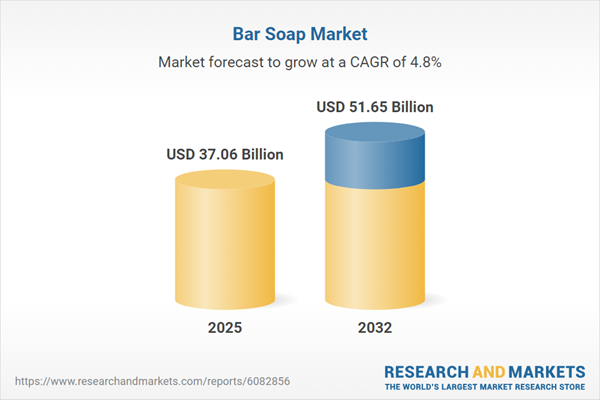Speak directly to the analyst to clarify any post sales queries you may have.
The global bar soap market is transforming rapidly as it responds to evolving consumer preferences, digital innovation, and regulatory changes. Senior decision-makers must navigate a more complex landscape, marked by shifting demands, emerging technologies, and increased scrutiny around sustainability.
Market Snapshot: Bar Soap Market Growth Outlook
The bar soap market expanded from USD 35.37 billion in 2024 to USD 37.06 billion in 2025, with projections indicating continued robust growth at a 4.84% CAGR to USD 51.65 billion by 2032. This trajectory is shaped by consumer shifts toward wellness, personalized care, and environmental consciousness, providing a dynamic environment with opportunities for both established and emerging players.
Scope & Segmentation of the Bar Soap Market
This report delivers in-depth analysis across critical segments, helping leaders pinpoint growth opportunities and exposures:
- Product Types: Antibacterial Soap, Glycerin Soap, Medicated Soap, Toilet Soap
- Distribution Channels: Offline (including Convenience Stores, Pharmacy & Drug Stores, Supermarkets & Hypermarkets), Online (Direct-To-Consumer Websites, E-Commerce Platforms)
- Price Range: Economy, Luxury, Mass, Premium
- End Users: Children, Men, Women
- Ingredients: Antibacterial, Natural, Organic, Synthetic
- Regional Insights: Americas (United States, Canada, Mexico, Brazil, Argentina, Chile, Colombia, Peru), Europe, Middle East & Africa (United Kingdom, Germany, France, Russia, Italy, Spain, Netherlands, Sweden, Poland, Switzerland, UAE, Saudi Arabia, Qatar, Turkey, Israel, South Africa, Nigeria, Egypt, Kenya), Asia-Pacific (China, India, Japan, Australia, South Korea, Indonesia, Thailand, Malaysia, Singapore, Taiwan)
- Key Companies: The Procter & Gamble Company, Unilever PLC, Colgate-Palmolive Company, Henkel AG & Co. KGaA, Beiersdorf AG, Reckitt Benckiser Group plc, Kao Corporation, L'Oréal S.A., Johnson & Johnson, Godrej Consumer Products Limited
Key Takeaways for Bar Soap Market Leadership
- Consumer demand now favors wellness, skin-friendly, and ethically sourced formulations, prompting significant product innovation among both global and niche brands.
- Sustainability is integral across the value chain, with emphasis on biodegradable packaging and traceable, natural ingredients shaping product positioning and customer loyalty.
- Digital channels and advanced analytics are redefining engagement and sales, from tailored influencer marketing to AI-powered product recommendations and immersive virtual shopping experiences.
- End-to-end supply chain visibility and blockchain adoption are on the rise, enhancing quality assurance and transparency in an increasingly regulated environment.
- Manufacturing strategies now include nearshoring and regional diversification to manage cost volatility and tariff risks, safeguarding both margins and supply reliability.
Tariff Impact: Navigating Regulatory and Cost Pressures
Recent U.S. tariff implementations have altered sourcing and manufacturing decisions for bar soap manufacturers. Firms are mitigating cost increases through partnerships with domestic suppliers and local ingredient cultivators. Enhanced supply chain visibility tools and analytics allow rapid response to pricing shifts, while regional realignment of production facilities reduces exposure to tariff-related disruptions. Strategic tariff scenario planning is increasingly critical to sustaining profitability and operational resilience in the sector.
Methodology & Data Sources
This report applies a multi-source approach, combining primary interviews with executives, procurement leaders, and focus groups with secondary analysis of company filings, regulatory records, and industry publications. Data triangulation, retail audits, and scenario modeling underpin the findings, ensuring robust, actionable market intelligence for decision-makers.
Why This Report Matters to Senior Decision-Makers
- Supports strategic planning by identifying growth drivers, risk areas, and high-value market segments aligned with current and emerging consumer preferences.
- Enables competitive positioning and scenario planning by benchmarking innovations, sustainability initiatives, and production strategies across key regional markets and leading companies.
- Provides concrete recommendations on R&D, digital transformation, supply chain integrity, and regulatory compliance to help maintain competitiveness.
Conclusion
Senior leaders leveraging this bar soap market report gain a decisive advantage in understanding disruptive trends, competitive moves, and market opportunities. The intelligence provided supports agile decision-making and long-term resilience in a complex, evolving sector.
Table of Contents
3. Executive Summary
4. Market Overview
7. Cumulative Impact of Artificial Intelligence 2025
Companies Mentioned
The companies profiled in this Bar Soap market report include:- The Procter & Gamble Company
- Unilever PLC
- Colgate-Palmolive Company
- Henkel AG & Co. KGaA
- Beiersdorf AG
- Reckitt Benckiser Group plc
- Kao Corporation
- L'Oréal S.A.
- Johnson & Johnson
- Godrej Consumer Products Limited
Table Information
| Report Attribute | Details |
|---|---|
| No. of Pages | 198 |
| Published | October 2025 |
| Forecast Period | 2025 - 2032 |
| Estimated Market Value ( USD | $ 37.06 Billion |
| Forecasted Market Value ( USD | $ 51.65 Billion |
| Compound Annual Growth Rate | 4.8% |
| Regions Covered | Global |
| No. of Companies Mentioned | 11 |









